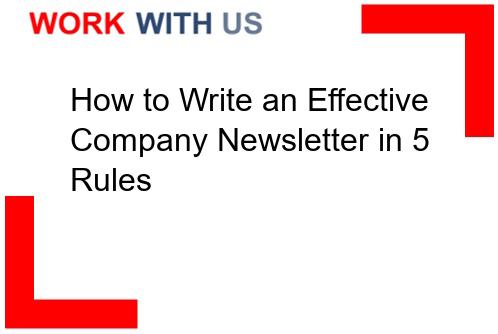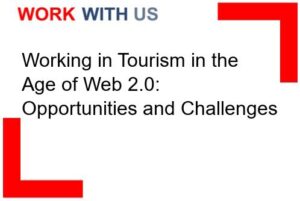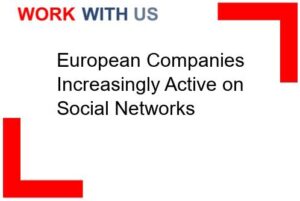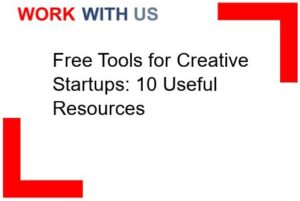Writing an effective company newsletter is crucial for maintaining strong communication with employees, clients, and stakeholders. A well-crafted newsletter can inform, engage, and inspire its readers, fostering a sense of community and promoting the company’s goals and values. To ensure that your company newsletter achieves these objectives, there are five essential rules to follow.
Firstly, an effective company newsletter should have a clear purpose and target audience. Before starting the writing process, it is important to define the goals of the newsletter and identify the specific group of people it aims to reach. Whether it is intended for employees, clients, or both, understanding the target audience will help tailor the content and tone accordingly. For instance, an internal newsletter may focus on company updates, employee achievements, and upcoming events, while an external newsletter may highlight new products, industry trends, and customer success stories.
Secondly, the newsletter should be visually appealing and well-structured. A cluttered and unorganized layout can discourage readers from engaging with the content. Utilizing a clean design with appropriate headings, subheadings, and bullet points can make the newsletter more visually appealing and easier to navigate. Including relevant images, infographics, or charts can also enhance the overall look and feel of the newsletter, making it more engaging and memorable.
Thirdly, an effective company newsletter should provide valuable and relevant content. Readers should feel that their time spent reading the newsletter is worthwhile. Including a mix of informative articles, industry news, and practical tips can help keep readers engaged and interested. Additionally, featuring success stories, employee spotlights, or customer testimonials can create a sense of pride and connection within the company community. It is important to strike a balance between promoting the company’s achievements and providing valuable information to the readers.
Fourthly, the newsletter should be concise and easy to read. In today’s fast-paced world, people have limited time and attention spans. Therefore, it is crucial to present information in a concise and digestible manner. Using short paragraphs, bullet points, and subheadings can make the content more scannable and easier to comprehend. Additionally, using a conversational and friendly tone can help create a more approachable and engaging reading experience.
Lastly, an effective company newsletter should encourage interaction and feedback. Including a call-to-action at the end of each article or section can prompt readers to share their thoughts, ask questions, or provide feedback. This can be done through social media links, email addresses, or dedicated feedback forms. Actively engaging with readers’ responses and incorporating their suggestions in future newsletters can foster a sense of inclusivity and strengthen the bond between the company and its audience.
In conclusion, writing an effective company newsletter requires careful planning and execution. By following these five rules – defining purpose and target audience, creating a visually appealing layout, providing valuable content, ensuring readability, and encouraging interaction – companies can create newsletters that inform, engage, and inspire their readers. A well-crafted newsletter can serve as a powerful tool for building strong relationships, promoting company values, and fostering a sense of community within the organization.
Crafting engaging content: tips for captivating readers in your company newsletter
In today’s digital age, where information overload is the norm, capturing and retaining readers’ attention in your company newsletter can be a challenging task. However, with the right strategies and techniques, you can create compelling content that not only grabs your readers’ attention but also keeps them coming back for more. Here are some valuable tips to help you craft engaging content for your company newsletter.
Begin with a Captivating Headline: The first step in captivating your readers is to create an attention-grabbing headline. A well-crafted headline should be concise, intriguing, and relevant to the content it introduces. It should pique the readers’ curiosity and compel them to delve deeper into the newsletter.
Know Your Audience: Understanding your target audience is crucial when crafting engaging content. Tailor your newsletter to their interests, preferences, and needs. Conduct surveys or analyze data to gain insights into their demographics, behaviors, and preferences. This knowledge will enable you to create content that resonates with your readers and keeps them engaged.
Tell a Story: Humans are naturally drawn to stories. Incorporating storytelling techniques in your newsletter can make it more relatable and captivating. Share success stories, customer testimonials, or anecdotes that highlight the impact of your company’s products or services. By weaving a narrative, you can create an emotional connection with your readers, making them more likely to engage with your content.
Use Visuals: Visual elements such as images, infographics, and videos can significantly enhance the appeal of your newsletter. Visual content not only breaks the monotony of text but also helps convey information more effectively. Incorporate relevant visuals that support your message and make your newsletter visually appealing and engaging.
Keep it Concise: In a fast-paced world, where attention spans are shrinking, it is essential to keep your newsletter concise and to the point. Avoid lengthy paragraphs and use bullet points, subheadings, and short sentences to make your content easily scannable. By presenting information in a clear and concise manner, you increase the chances of capturing and retaining your readers’ attention.
Provide Value: Your company newsletter should offer valuable and relevant content to your readers. Whether it’s industry insights, expert advice, or exclusive offers, ensure that your content provides something of worth to your audience. By consistently delivering valuable content, you establish your newsletter as a trusted source of information, keeping readers engaged and eager for more.
Incorporate Interactive Elements: Engage your readers by incorporating interactive elements in your newsletter. Polls, quizzes, surveys, or interactive infographics can make your content more interactive and encourage reader participation. Interactive elements not only make your newsletter more enjoyable but also provide valuable insights into your readers’ preferences and opinions.
Personalize Your Content: Personalization is key to capturing readers’ attention. Address your readers by their names, segment your audience based on their interests, and tailor your content accordingly. By personalizing your newsletter, you make your readers feel valued and increase the likelihood of them engaging with your content.
Use a Conversational Tone: Avoid using overly formal or technical language in your newsletter. Instead, adopt a conversational tone that is easy to understand and relatable. Write as if you are having a conversation with your readers, making your content more approachable and engaging.
10. Encourage Feedback and Interaction: Actively encourage your readers to provide feedback, share their thoughts, and engage in discussions. Include a call-to-action at the end of each newsletter, inviting readers to leave comments, ask questions, or share their experiences. By fostering a sense of community and interaction, you create a more engaging and dynamic newsletter.
In conclusion, crafting engaging content for your company newsletter requires careful consideration of your audience’s preferences, storytelling techniques, visual elements, and personalization. By implementing these tips, you can captivate your readers, keep them engaged, and ultimately build a loyal and enthusiastic readership for your company newsletter.
Designing a visually appealing newsletter: enhancing the aesthetics to grab attention
Designing a visually appealing newsletter is crucial in today’s digital age where attention spans are short and competition for readers’ attention is fierce. A well-designed newsletter not only grabs attention but also enhances the overall user experience, making it more likely for readers to engage with the content. From choosing the right color scheme to incorporating eye-catching visuals, there are several key elements to consider when designing a newsletter that stands out from the crowd.
Choosing the Right Color Scheme
One of the first steps in designing a visually appealing newsletter is selecting the right color scheme. Colors have a significant impact on how readers perceive and engage with content. It is important to choose colors that align with the brand’s identity and evoke the desired emotions. For instance, warm colors like red and orange can create a sense of urgency or excitement, while cool colors like blue and green can convey a sense of calmness or trustworthiness. A harmonious color palette that complements the brand’s logo and overall aesthetic can greatly enhance the visual appeal of the newsletter.
Incorporating Eye-Catching Visuals
Visual elements play a crucial role in capturing readers’ attention and making the newsletter visually appealing. Incorporating high-quality images, illustrations, or infographics can make the content more engaging and memorable. It is important to choose visuals that are relevant to the content and align with the brand’s style. Additionally, using white space strategically can help create a clean and organized layout, allowing the visuals to shine. By striking the right balance between text and visuals, the newsletter becomes visually appealing and easy to digest.
Utilizing Typography Effectively
Typography is another important aspect of designing a visually appealing newsletter. Choosing the right fonts and using them consistently throughout the newsletter can create a cohesive and professional look. It is advisable to use a combination of fonts, such as a bold headline font paired with a clean and legible body font. Additionally, playing with font sizes, weights, and colors can help emphasize important information and guide readers’ attention. However, it is important to maintain readability by ensuring that the font size is appropriate and the text is easily legible.
Creating a Clear Hierarchy
A visually appealing newsletter should have a clear hierarchy that guides readers through the content. By using headings, subheadings, and bullet points, the designer can create a visual structure that makes it easy for readers to scan and navigate the newsletter. Important information should be highlighted using larger fonts, bold text, or color variations. By creating a clear hierarchy, the newsletter becomes more visually appealing and user-friendly, allowing readers to quickly find the information they are interested in.
Optimizing for Mobile Devices
In today’s mobile-centric world, it is essential to design newsletters that are optimized for mobile devices. With a significant portion of readers accessing emails on their smartphones or tablets, it is crucial to ensure that the newsletter is responsive and adapts to different screen sizes. This includes using a mobile-friendly layout, optimizing images for faster loading times, and using fonts that are easily readable on smaller screens. By designing newsletters with mobile devices in mind, the visual appeal is maintained across different platforms, ensuring a seamless user experience.
The Power of Personalization
Personalization is a powerful tool in designing a visually appealing newsletter. By tailoring the content to the specific interests and preferences of the target audience, the newsletter becomes more relevant and engaging. This can be achieved through dynamic content blocks that display different content based on the recipient’s demographics or past interactions. Additionally, using the recipient’s name in the subject line or greeting can create a sense of personal connection. By personalizing the newsletter, the visual appeal is enhanced as readers feel a stronger connection to the content.
The Role of Call-to-Action
A visually appealing newsletter should have a clear and compelling call-to-action (CTA) that encourages readers to take the desired action. Whether it is to visit a website, make a purchase, or sign up for an event, the CTA should stand out and be visually distinct from the rest of the content. This can be achieved through the use of contrasting colors, larger font sizes, or buttons. By designing a visually appealing CTA, readers are more likely to engage with the content and convert into customers or subscribers.
The Importance of Testing and Iteration
Designing a visually appealing newsletter is an iterative process that requires testing and refinement. It is important to gather feedback from readers and analyze the performance of different design elements. A/B testing can be used to compare the effectiveness of different color schemes, visuals, or CTAs. By continuously testing and iterating, the designer can optimize the visual appeal of the newsletter and ensure that it resonates with the target audience.
In conclusion, designing a visually appealing newsletter involves careful consideration of color schemes, visuals, typography, hierarchy, mobile optimization, personalization, CTAs, and continuous testing. By incorporating these elements effectively, the newsletter becomes visually appealing, engaging, and memorable. In today’s competitive digital landscape, a visually appealing newsletter can make all the difference in capturing readers’ attention and driving meaningful engagement.
Building a strong brand voice: creating consistency and personality in your newsletter
In today’s competitive business landscape, establishing a strong brand voice is crucial for success. A brand voice is the unique personality and tone that a company uses to communicate with its audience. One powerful tool for showcasing this brand voice is through a well-crafted newsletter. By creating consistency and infusing personality into your newsletter, you can effectively engage your readers and build a loyal following.
Consistency is key when it comes to building a strong brand voice in your newsletter. From the design elements to the language used, every aspect should align with your brand’s identity. Start by defining your brand’s core values, mission, and target audience. This foundation will guide you in creating content that resonates with your readers and reflects your brand’s personality.
When it comes to design, ensure that your newsletter template reflects your brand’s visual identity. Use consistent colors, fonts, and imagery that are in line with your brand guidelines. This visual consistency will help readers instantly recognize your newsletter and associate it with your brand.
In addition to visual consistency, the language and tone used in your newsletter should also reflect your brand’s personality. Consider the voice you want to convey – whether it’s friendly, professional, humorous, or authoritative – and tailor your writing style accordingly. Use language that resonates with your target audience and aligns with your brand’s values. Consistency in tone will help establish a strong brand identity and build trust with your readers.
While consistency is important, injecting personality into your newsletter is equally crucial. A generic and impersonal newsletter is unlikely to capture your readers’ attention or leave a lasting impression. Instead, infuse your newsletter with your brand’s unique personality to make it more engaging and memorable.
One way to add personality is by incorporating storytelling into your newsletter. Share anecdotes, success stories, or behind-the-scenes glimpses that humanize your brand. This personal touch will help readers connect with your brand on a deeper level and foster a sense of loyalty.
Another effective way to showcase your brand’s personality is through the use of humor. Depending on your brand’s identity, injecting humor into your newsletter can make it more enjoyable to read and leave a positive impression. However, it is important to strike a balance and ensure that the humor aligns with your brand’s values and doesn’t offend or alienate your audience.
Furthermore, engaging with your readers on a personal level can also help build a strong brand voice. Address your readers by their names, ask for their opinions, and encourage them to interact with your content. This personalized approach will make your readers feel valued and create a sense of community around your brand.
Lastly, don’t be afraid to experiment and evolve your brand voice over time. As your business grows and your target audience evolves, your brand voice may need to adapt as well. Regularly review and analyze the performance of your newsletter to understand what resonates with your readers and make necessary adjustments.
In conclusion, building a strong brand voice in your newsletter requires both consistency and personality. By aligning your newsletter’s design, language, and tone with your brand’s identity, you can create a cohesive and recognizable experience for your readers. Infusing your newsletter with storytelling, humor, and personalization will make it more engaging and memorable. Remember to regularly evaluate and refine your brand voice to ensure it remains relevant and resonates with your evolving audience. With a well-crafted newsletter, you can effectively communicate your brand’s personality, build a loyal following, and ultimately drive business success.
Maximizing open rates: strategies to ensure your company newsletter gets read
In today’s digital age, where information overload is a common phenomenon, it is crucial for businesses to find effective ways to cut through the noise and capture the attention of their target audience. One powerful tool that can help achieve this is a well-crafted company newsletter. However, simply sending out a newsletter is not enough; it is equally important to ensure that it gets read. This comprehensive text will delve into various strategies that businesses can employ to maximize open rates and ensure their company newsletter is not only opened but also read and engaged with by recipients.
Segmentation: Tailoring content to specific audiences
One of the key strategies to maximize open rates is to segment your newsletter subscribers based on their interests, preferences, and demographics. By understanding your audience and tailoring the content to their specific needs, you can significantly increase the chances of your newsletter being opened and read. For instance, if you have a diverse customer base, you can create different versions of your newsletter that cater to each segment’s unique interests. This personalized approach will make your subscribers feel valued and increase the likelihood of engagement.
Compelling subject lines: Captivating the reader’s attention
The subject line of your newsletter plays a crucial role in determining whether it gets opened or ignored. A compelling subject line should be concise, intriguing, and create a sense of urgency or curiosity. It should give the reader a glimpse of what they can expect from the newsletter, enticing them to open it. Experimenting with different subject lines and analyzing their performance can help you identify what resonates best with your audience. Additionally, avoiding spam trigger words and personalizing subject lines with the recipient’s name can also boost open rates.
Consistent and valuable content: Building trust and credibility
To ensure your company newsletter gets read, it is essential to consistently deliver valuable content that meets the needs and interests of your subscribers. The content should be informative, relevant, and provide actionable insights or solutions to their problems. By consistently delivering high-quality content, you build trust and credibility with your audience, making them more likely to open and engage with future newsletters. Incorporating a mix of different content formats, such as articles, videos, infographics, and case studies, can also help keep the newsletter fresh and engaging.
Optimize for mobile: Reaching readers on the go
With the increasing use of smartphones and tablets, optimizing your company newsletter for mobile devices is crucial. A significant portion of your subscribers is likely to access their emails on mobile devices, and if your newsletter is not mobile-friendly, it may be quickly discarded. Ensure that your newsletter is responsive, with a clean and visually appealing design that adapts to different screen sizes. Pay attention to font sizes, image sizes, and overall readability on mobile devices. By making your newsletter easily accessible on mobile, you increase the chances of it being opened and read.
Timing and frequency: Finding the sweet spot
The timing and frequency of your newsletter can greatly impact open rates. It is important to find the sweet spot that works best for your audience. Analyze data and metrics to determine when your subscribers are most likely to engage with your newsletter. Experiment with different send times and days of the week to identify patterns and optimize your delivery schedule. Additionally, striking the right balance between sending newsletters too frequently and not frequently enough is crucial. Bombarding your subscribers with too many emails can lead to fatigue and unsubscribes, while infrequent newsletters may cause your audience to lose interest. Finding the right balance will help maximize open rates and keep your subscribers engaged.
In conclusion, maximizing open rates for your company newsletter requires a combination of strategic approaches. By segmenting your audience, crafting compelling subject lines, consistently delivering valuable content, optimizing for mobile, and finding the right timing and frequency, you can significantly increase the chances of your newsletter being opened and read. Remember, the key is to understand your audience, cater to their needs, and provide them with valuable information that keeps them engaged and eager to open your newsletters.



